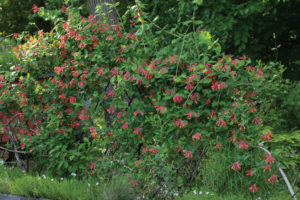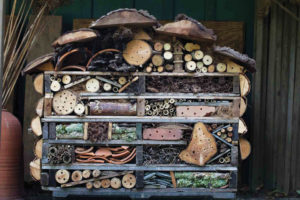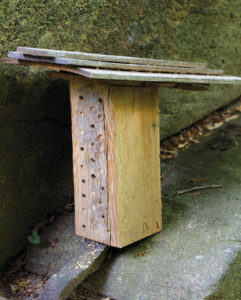Gardening for Wildlife
Images courtesy of Chanticleer, by Lisa RoperIdeas for creating a natural habitat in your garden

Successful and responsible gardening in today’s ever-changing climate calls for including wildlife in the garden. As natural habitats disappear, it’s more important than ever for gardeners to create wildlife-friendly environments wherever possible.
From an urban container garden to a rambling country estate, many different kinds of sites can invite wildlife to make a temporary stop, a seasonal nest or permanent home in your garden. A visit to your local arboretum or public garden (Chanticleer’s Bell’s Woodland, in particular) provides examples of how a garden can be a welcome habitat for birds, fish, insects and pollinators.
Here are some ideas to help you create a home garden that supports and encourages wildlife.
Choose Native Plants
All wildlife needs the basics—food, water and shelter. Plants and wildlife native to our region evolved symbiotically over time, so choosing native plants creates a welcoming natural habitat. Many birds and pollinators are drawn to native plants for food, shelter and rearing their young. And wildlife does its part by helping plants reproduce by dispersing pollen, berries or seeds.
 Fortunately, native plants can be a fascinating, attractive and environmentally positive addition to your garden plantings. You’ll find that most local nurseries grow a selection of native plants—including grasses, perennials, ferns, wildflowers, shrubs and trees—and can help you choose what best suits your garden, based on factors such as soil type, moisture condition and sunlight.
Fortunately, native plants can be a fascinating, attractive and environmentally positive addition to your garden plantings. You’ll find that most local nurseries grow a selection of native plants—including grasses, perennials, ferns, wildflowers, shrubs and trees—and can help you choose what best suits your garden, based on factors such as soil type, moisture condition and sunlight.
There are plenty of choices that will bring visual beauty and wildlife to your garden year round. Early spring is marked by delicate wildflowers and flowering native shrubs and trees. Then come the vibrant colors of flowering summer perennials. Many native shrubs and trees produce attractive fruits and berries in the summer and autumn months. And don’t forget the glory of colorful fall foliage and attention-grabbing tree bark in the winter.
Native plants will provide a year-round wildlife show of flitting butterflies and moths, swooping and singing birds, and a variety of seen and unseen beneficial insects.
For inspiration, try a walk through Chanticleer to find native plants for your garden.
Build a Hugelkulter Bed
Hugelkulter, (pronounced hoo-gul-culture) meaning hill culture or hill mound, is a gardening technique that creates a mound from fallen branches and other decaying wood debris, covered with compost, topped with soil and later used as a raised bed. As the wood and debris decompose, the mound comes alive with microbial activity, creating valuable nutrients for plant growth.
This method works wonders for improving poor or compacted garden soil. When properly constructed, it’s self-fertilizing, self-irrigating and self-aerating. Chanticleer Horticulturist Przemek Walczak has been incorporating hugelkulter throughout Bell’s Woodland to enrich the soil and encourage growth of beneficial organisms.
To construct a hugelkulter bed, begin with a bottom layer of large branches or logs—preferably hardwoods because they decompose slowly and provide years of organic matter and microbial activity. Take care to avoid black locust (which won’t decompose) and black walnut (which has juglone toxin).
Next, layer smaller branches and compostable materials, such as leaves, grass clippings, straw, cardboard, petroleum-free newspaper, manure or compost. The final topping is soil. Voila! You’ve created a welcome home for beneficial organisms to thrive and a new planting bed for your garden.
Leave a Snag
Another valuable practice that improves wildlife habitat is leaving snags in the landscape. Snags? Yes, trunks of dead or dying trees left standing to decompose naturally—with limbs removed for safety—to provide shelter and food for birds, animals and insects. Decomposing snags also enhance microbial growth and enrich the soil.
Chanticleer has been leaving snags in the garden for over a decade. These snags have encouraged birds to nest in the dead tree cavities, attracting many woodpeckers, nuthatches, chickadees, flycatchers and owls. Because most cavity-nesting birds eat insects, they play a critical role controlling tree-killing bark beetles and other unwanted insects.
If you’re inspired to add a snag to your landscape, it’s best to work with your local tree care professional. Depending on the species of the tree, snags decompose at different rates and stand for varying lengths of time. That makes safety an important consideration. A safe height for a snag depends on where it’s located, avoiding proximity to buildings, walkways, roads and seating areas.
If your garden isn’t conducive to snags, leaving logs and branches is a good alternative, since they also provide habitat and food for wildlife. With this new-found knowledge, you may also want to talk with your neighbors about the ecological value of snags.
Create a Bee Hotel
Attracting pollinators to your garden is a top priority because of their importance to the life cycle of flowering plants and food crops. One of the most effective pollinators in our region is the solitary bee, which generally includes mason bees, leafcutter bees and miner bees.
 These solitary bees differ from honeybees and bumblebees because, as the name implies, they don’t live in colonies. Nor do they produce honey or have a queen. Solitary bees are also native, non-aggressive and don’t swarm, so they’re considered safe around children and pets.
These solitary bees differ from honeybees and bumblebees because, as the name implies, they don’t live in colonies. Nor do they produce honey or have a queen. Solitary bees are also native, non-aggressive and don’t swarm, so they’re considered safe around children and pets.
You can build a hotel to attract hole-nesting bees to your garden. All you need is untreated wood, a hammer, drill with bits. The design can be as simple and rustic as a 4×4 block of wood with holes drilled into it.
Hole nests are created by drilling holes of varying diameters—between 2mm and 10mm—with a depth about the length of a drill bit. Make sure the holes have smooth entries with no splinters. Fix the nest to a wall or post that faces the sun, at least three feet off the ground.
Fancier hotels can include small bee hotels and found objects enclosed in a wooden frame with a protective roof. A good example can be found at Chanticleer behind the Potting Shed.
If you’re interested in attracting wildlife to your backyard, you can learn about more techniques by joining Chanticleer staff for evening classes on ecological gardening, ornamental vines and other topics. Learn more about these classes on the website.
Chanticleer is a dynamic garden that’s ever changing. The staff welcomes guests to visit, observe the garden through each season, and ask questions when you see someone tending an area. The garden opens April 1st and remains open through October, Wed.—Sun., 10 to 5, and until 8 p.m. on Fri. from May to Labor Day. 786 Church Rd., Wayne, ChanticleerGarden.org.
Our Favorite Resources
- Ball & Ball
- Berk Hathaway Country Properties
- Berk Hathaway Holly Gross
- Berk Hathaway M. Schwartz
- Canvas Valley Forge
- Closet Factory
- Dewson Construction
- DiSabatino Landscaping
- Homestead Structures
- King Construction
- Main Street Cabinet
- McComsey Builders
- Monument/Sotheby’s Int’l
- Mostardi Nursery
- Renewal Dynamics
- Sheller Energy
- White Horse Construction
